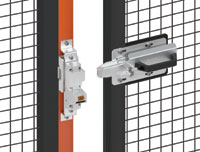
Posted to News on 23rd Nov 2018, 00:00
Ensuring safety for access doors and machine guards
In efforts to ensure safety from machinery behind access doors and machine guards, fault exclusions are often an under estimated risk. Arthur Aartsen of Dold examines requirements for safety switch and trapped key interlock transfer systems.

In addition to functionality and functional safety, cost can play a decisive role in the commercial competitiveness of machinery and plant. However despite taking into account all cost constraints, the critical view of making the compromise should also take into account the associated incalculable follow-up costs if an injury is caused by a component failure. For example, accepting fault exclusions for the sake of an apparent cost saving, involve a significant potential risk.
When developing a safety system for plant or machinery, its suitability for a specific application must be taken into account when selecting and assembling the safety components. This is determined not only by mechanical features such as strength, stability and choice of the right materials, but also by normative requirements and the safety aspects, such as structure (safety category), reliability (MTTFd) and fault detection mechanisms (DC).
However, designers and planners often come up against technical limitations in this regard, which they can only eliminate by excluding a fault. According to section 7.3 of EN ISO 13849-1, fault exclusions are a compromise between the technical safety requirements and the theoretical possibility of a fault occurring. Before considering fault exclusions in a safety system, the reasons for the exclusion must be carefully considered. It should be noted that in accordance with the general principles of the Machinery Directive 2006/42/EC, the ‘current state of the art’ must be observed when a safety product is selected. Under certain conditions it may be necessary to exclude a fault, for example the preconditions for this include the improbability of the faults occurrence, technical experience and the technical requirements with regard to the application and the hazard.
The risk is then assessed and the solution chosen is the responsibility of the designer. However the situation differs if fault exclusions are made for financial reasons, for example by using lower cost safety components that require fault exclusions to comply with the norms, even though a known compliant technical solution exists that does not require a fault exclusion.
One should always be aware of the consequences of accepting fault exclusions: the person(s) who accept and claim fault exclusions, can be held liable in the event of a fault occurring. In addition, the reasons for the fault exclusion must be listed in the safety documentation and enclosed with the machine or plant technical file. This demonstrates a clear disadvantage, compared to the use of safety products that do not require fault exclusions.
If an excluded fault should occur, it’s direct consequences cannot be neglected and, curative action must be taken, not only for the system affected but for any machinery and plant already delivered. This is typically demonstrated by the well-known campaigns for recall and retrofit in the automotive industry. Machine manufacturers who procure safety components with fault exclusions, should be aware that they may considered liable in the event of a fault.
For this reason Dold has developed a safety switch and key transfer system without compromise – Safemaster STS. This TÜV-certified system, which is available in stainless steel and fibre reinforced polymer, is suitable for standalone use in safety applications up to category
4 / PLe according to EN/ISO13849-1 – without any fault exclusions.
This does not relieve the designer or system planner of his responsibility, but at least makes the decision easier, because with Safemaster STS he is specifying a safety product that is third party certified – without fault exclusions. In addition, Safemaster STS offers other important advantages such as its modular design and retrofit expandability, which can grow with the user’s application.
Safemaster STS combines the advantage of safety switches, guard locks, trapped key transfer and command functions all in one system. The modular, expandable system has the ability to safeguard access doors without wiring therefore reducing installation, retrofitting and maintenance cost. In addition the stainless steel versions offer a solution that can withstand even the roughest environmental conditions.
We can see, then, that if machine designers want to minimise the risk liability for their machinery and plant, the use of safety components that conform to the highest safety requirements is recommended. The components should reach the required performance level without fault exclusions being necessary, regardless of the acquisition cost. This strategy is proven to be more cost effective in the long term, as it protects against incalculable risks and possible recourse claims.
11 Hamberts Road
Blackall Industrial Estate
CM3 5UW
UNITED KINGDOM
+44 (0)1245 324432






